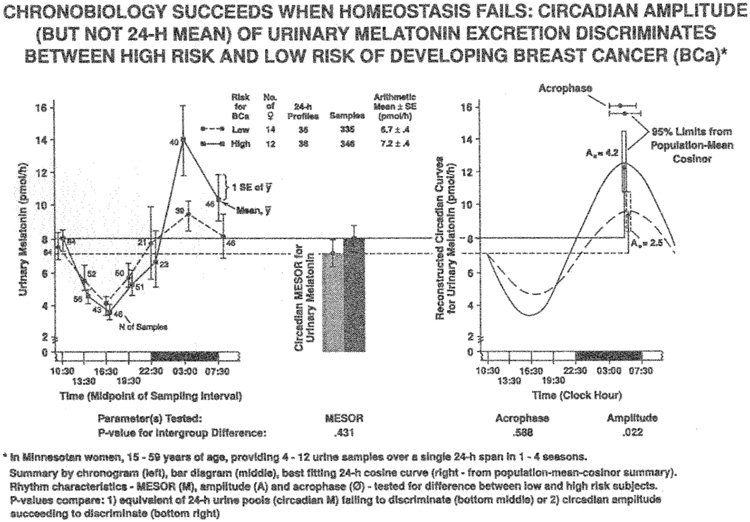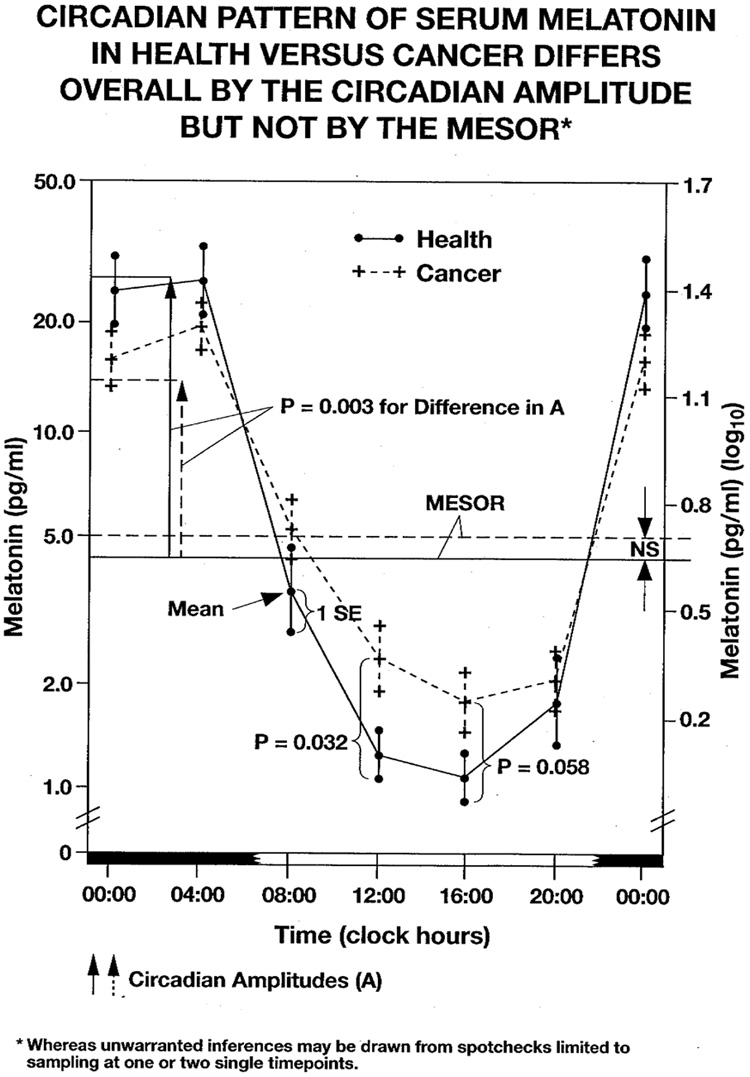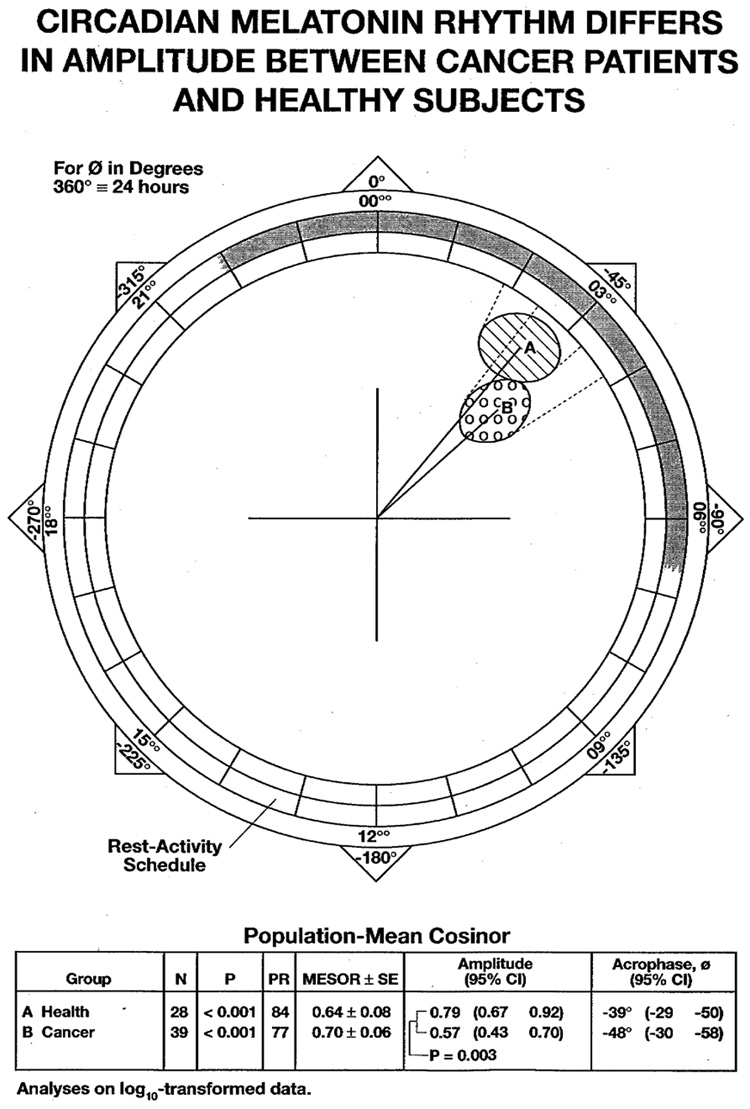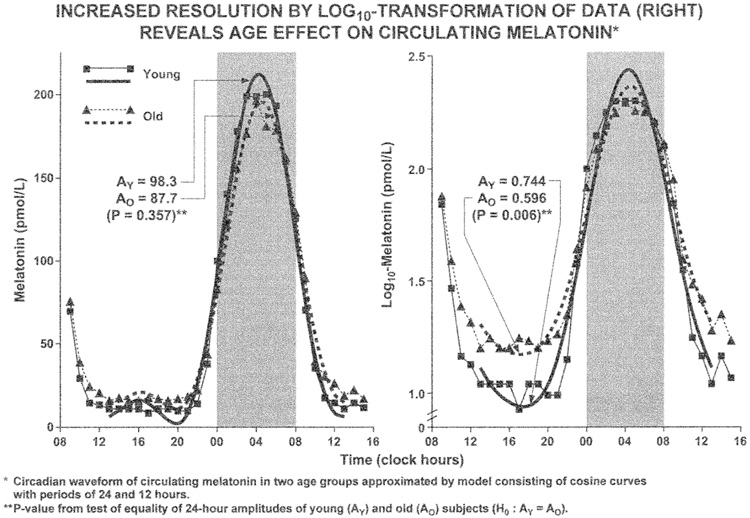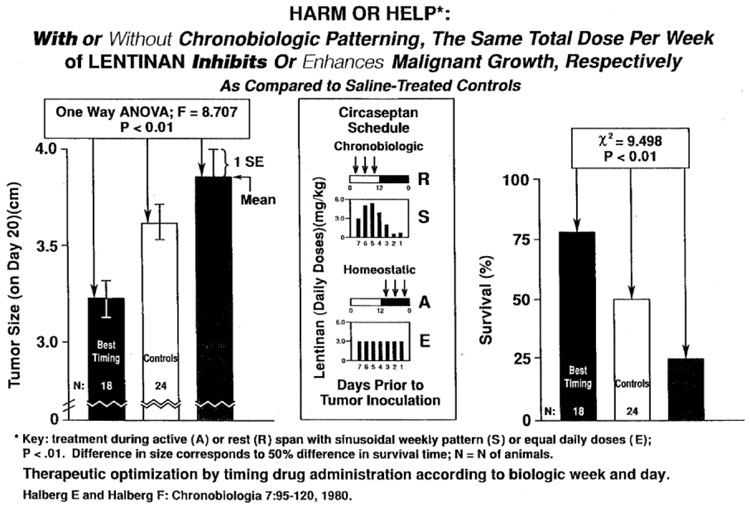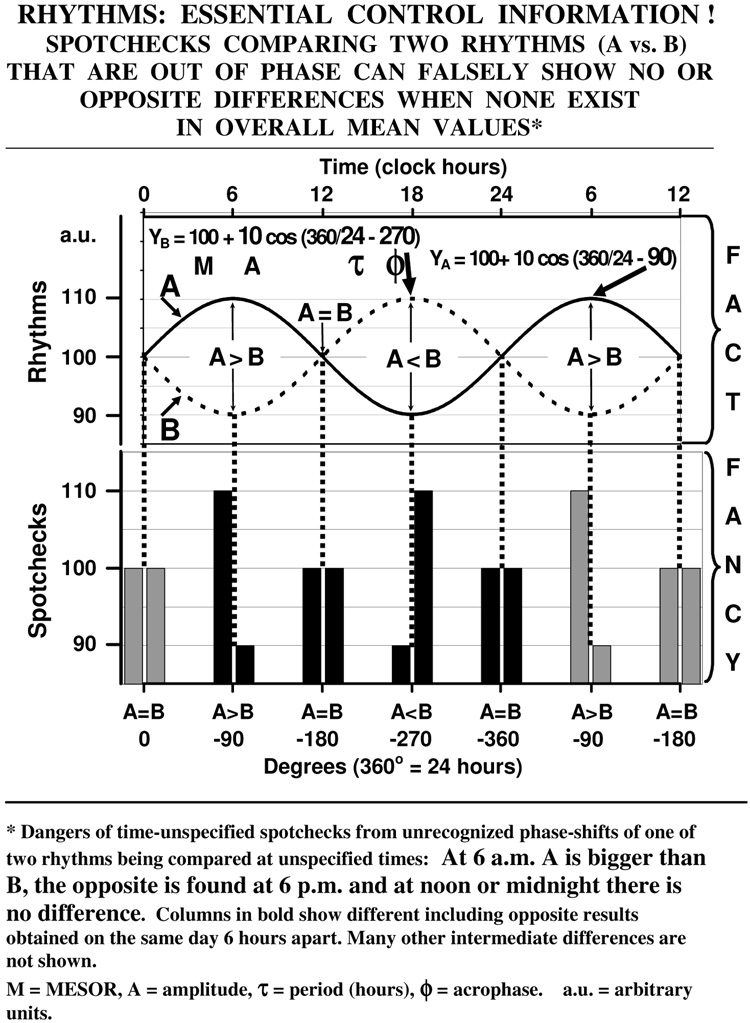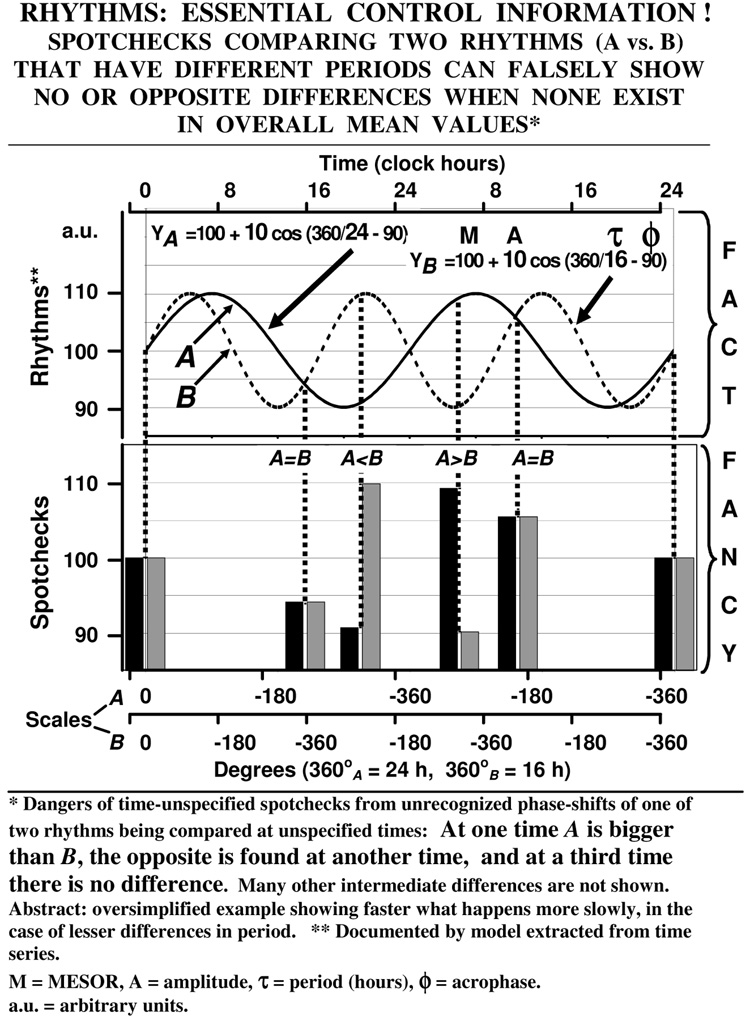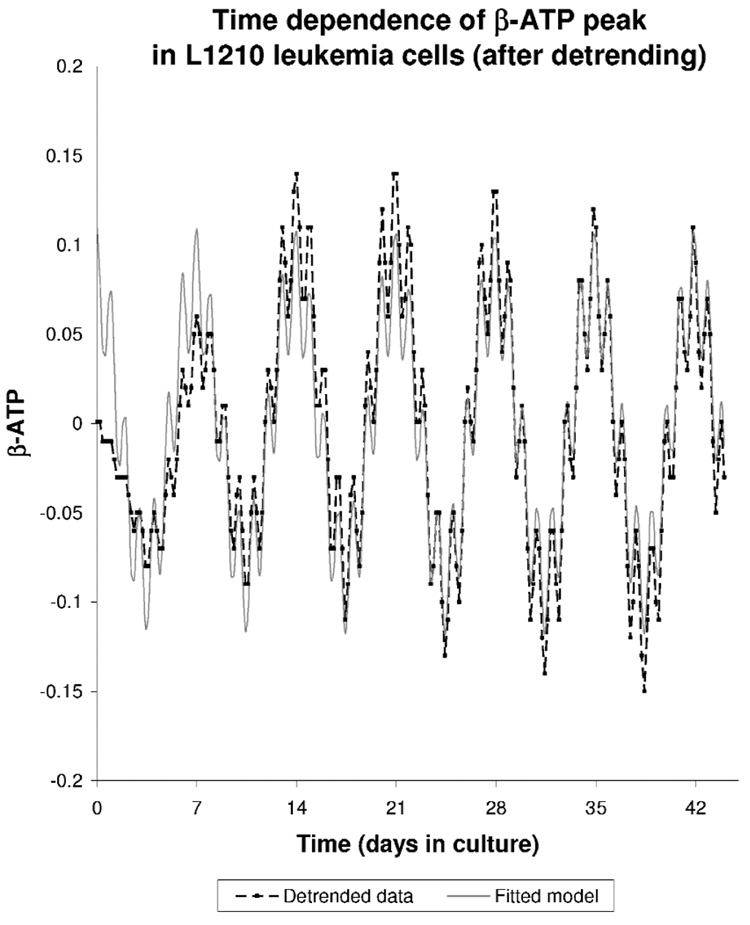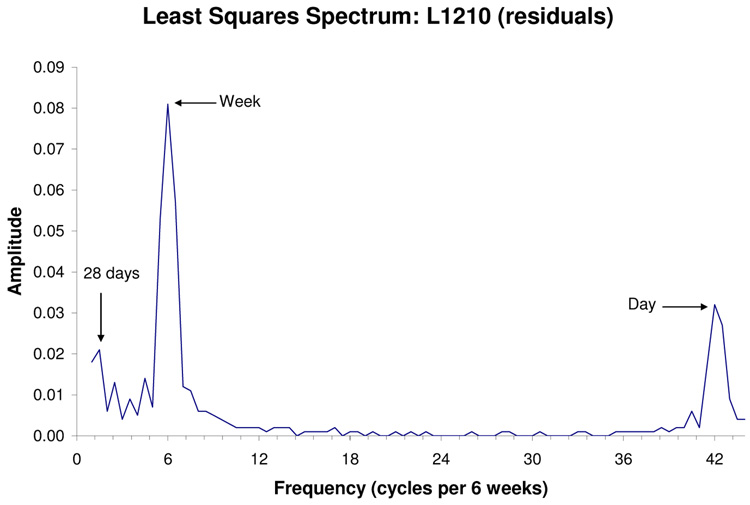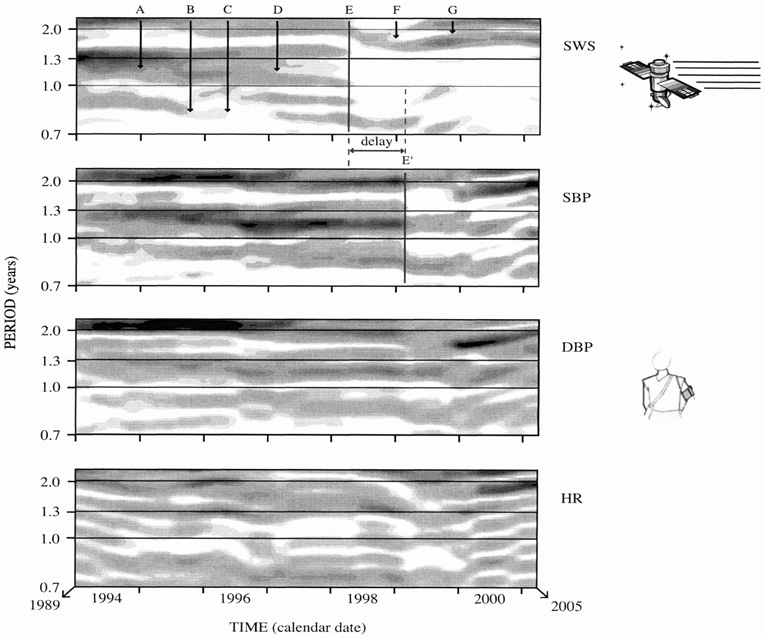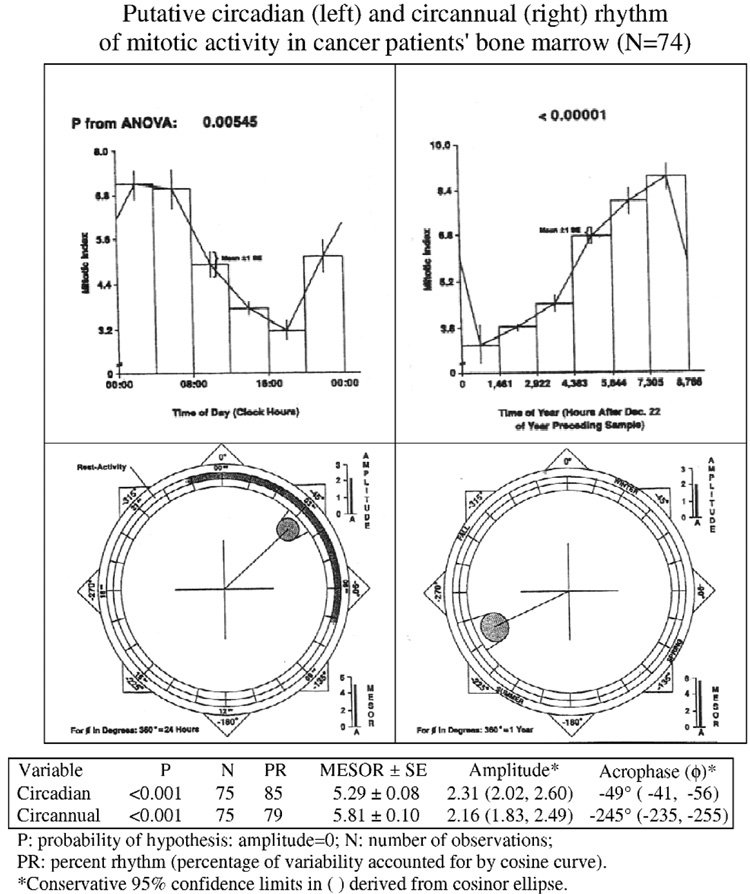Abstract
This position paper documents the merit of including for basic and clinical investigations the mapping of circadian and other rhythms and yet broader chronomes, time structures in and around us. Chronobiometry used herein relies on inferential statistical methods and on materials documented earlier. The circadian amplitude of melatonin is shown to relate both to cancer risk and to the presence of overt cancer, when no differences are found in the 24-hour average of melatonin. Optimization of treatment by timing, thoroughly documented along the circadian scale earlier, could be broadened to include optimization along the scale of the week, and eventually beyond. In both cases, reliance on marker rhythmometry is advocated. More generally, the limits of knowledge are expanded by considering already mapped spectral components and their characteristics that can be influenced by the dynamics of heliogeomagnetic signals heretofore unassessed.
Keywords: chronome, chronotherapy, circadian, circaseptan, heliogeomagnetics, L1210 leukemia, marker rhythmometry, mitotic activity
INTRODUCTION
The merit of consulting and testing chronomes — time structures—as gauges of health for alterations with disease risk elevation and actual illness was discussed both in general terms (1, 2) and with respect to melatonin and cancer (3), albeit in the latter case without underlying data or citations. Herein, we provide evidence supporting the importance of considering chronomics, the mapping of time structure in and around us. More specifically, in the context of a study based on the 24-hour excretion of metabolites of melatonin (4), it was noted that the single 24-hour average of melatonin does not provide necessarily time-keeping information and that studies “which demonstrate relationships between cancer risk and melatonin excretion, find this relationship between circadian amplitude or phase (time of melatonin upswing), not the average amount of melatonin metabolite excreted in 24 hours”. We here add data on the circadian amplitude that document the point of an association between cancer on the one hand and melatonin on the other and abstractly illustrate the need to also pay attention to other dynamic characteristics, phase and period. The detail concerns separately risk assessment, Figure 1a (5), and established cancer, Figures 1b and 1c (6–9). We amplify further on the importance of other time scales, including those of age, Figure 2 (10; see also 11), and of the week in Figure 3 (1) and provide citations for the importance of the scale of a set of calendar-year or photic and other non-photic biological and environmental periodisms.
Figure 1.
Figure 1a. Least-squares fit of 24-h cosine curve to urinary melatonin excretion documents circadian variation and assesses rhythm characteristics as point-and-interval estimates amenable to inferential statistical testing. Please note (middle) that there is no up- or down-regulation; there is no difference in MESOR (P = 0.431), in keeping with the Guernsey III study (4). By contrast, for the difference in amplitude, the relatively small sample notwithstanding, the likelihood that the difference is due to random sampling error is small: 0.022 (5). © Halberg.
Figure 1b. In the absence of a difference in MESOR of circulating melatonin, in the face of no up- or down-regulation, a difference in circadian amplitude is found between a group of 39 cancer patients and that of 28 healthy subjects. Cancer patients have numerically lower circulating melatonin concentrations during the rest span but statistically significantly higher melatonin concentrations during the active span (around noon). Inter-group difference in MESOR is not statistically significant (NS). Note further a P of 0.032 for a difference around noon, which reverses sign around midnight (6–9). © Halberg.
Figure 1c. Cosinor display of circadian rhythm in circulating melatonin concentration in cancer patients by comparison with healthy subjects. © Halberg.
Figure 2.
In data taken from a published graph (11), a smaller circadian amplitude can be demonstrated in older subjects when the data have been log10-transformed (right), but not when they are expressed in original units (left) (10). In this case, the transformation reveals to the naked eye the inter-group difference by daytime. © Halberg.
Figure 3.
The same total dose of the same molecule, lentinan, depending on the circadian and circaseptan patterns of its administration, stimulates the growth of a malignancy on a conventional administration pattern while it inhibits the malignancy with sinusoidal administration (1). An undesirable harmful effect becomes a desirable one by accounting for chronomics. © Halberg.
In none of the figures shown herein is there any evidence for any up or down “regulation”—the kind of question raised when comparing, for two groups examined, the excretion of urinary melatonin metabolites in 24-hour samples collected to integrate, and inadvertently to eliminate any alteration of 24-hour rhythms. This is a meritorious approach as compared to spotchecks that are even simpler to collect and continue to characterize much current work, dispensing even with this minimal precaution of integrating over the period of a rhythm.
But there can be no increase or decrease in the chronome-adjusted average, i.e. the MESOR (midline-estimating statistic of rhythm), yet there can be nonetheless differences in variability. In each case herein, the difference lies in the dynamics and is lost if we ask, as is too often customary, exclusively about any “too much” or “too little” vs. “normal”, the latter two often handled as a constant. This approach of refraining from the study of rhythms is embraced for the sake of simplicity (read ignorance), or rather, with the accumulating evidence, as an aspect of indolence. It will be up to journal editors and referees, under such conditions when encountering negative results, to insist that it should be specified that the failure to find a difference could stem from a priori insufficient sampling and that more sampling remains to be done, if, in the face of ignoring broader chronomics, a paper is to be published at all.
MATERIALS AND METHODS
Chronobiometry used herein relies on inferential statistical methods and on materials illustrated, if not documented earlier (1).
RESULTS OR, RATHER, POSITION
Melatonin and Cancer Risk Versus Overt Cancer
Figure 1a shows that in the absence of known human cancer, the circadian amplitude of urinary melatonin excretion was elevated in women at high vs. low familial breast cancer risk (P=0.05) (5). There was no inter-group difference in the MESOR. Figure 1b shows that in overt cancer, irrespective of cancer site, the circadian amplitude of melatonin in cancer was smaller than that in health (P<0.05) (6–9). This result applied equally to men and women, again in the absence of a difference in MESOR. A cosinor analysis of the Figure 1b data, Figure 1c, reveals the statistical significance of the findings (6–9). In relation to both cancer risk and to overt cancer, differences in melatonin dynamics were found in relation to the circadian melatonin amplitude, in the absence of any difference in melatonin MESOR. This finding also applies to aging (6, 10). In the data published on the topic (11), a log10-transformation was needed to demonstrate a statistically significant difference in the circadian amplitude of melatonin as a function of age, a finding qualified by the fact that this procedure amplifies low values, including noise.
However large the number of patients is, a difference in amplitude necessarily implies that any tests at several different time-unqualified single sampling times are likely to run the risk of yielding confusing results. Thus, between certain test times, an inter-group difference can reverse sign when testing during the night (e.g., in overnight urine samples) vs. during the day (e.g., in the urine collected in the afternoon), Figure 1b (6–9). Both differences will be misleading when there is actually no difference in average (MESOR) operating concentration, as is the case in Figure 1.
The group results with fractionated samples around the clock revealing differences in circadian amplitude are compatible with the view that the increase in circadian amplitude of melatonin excretion, in the absence of an increase in MESOR, constitutes an early measure of strain, often described as “stress” (12–14). In that perspective, early stress/strain assessment requires an indispensable analysis of time structure. These lessons may serve those who focus only upon too much or too little and use a set of normal values, thereby inadvertently drawing a curtain of ignorance over the range in which all of our everyday physiology and much early pathology occur (1, 8, 9). That timing along the 24-hour and 7-day scales in the case of lentinan can make the difference between inhibiting and enhancing the growth of a subsequently implanted malignancy is also noteworthy, Figure 3 (1, 15). As a function of timing along the 1-year as well as 24-hour scales, melatonin can also have different results in carcinogenesis (16–20). The study prompting the earlier note (3) was carried out in Guernsey (III study) (4). In earlier data from Guernsey, a chronobiological meta-analysis already proved to be useful, yielding new information in a circadian and circannual perspective (21).
What Referees Should Assess Under “Methods”
Each investigator has several choices: Most of current science still ignores rhythms and accordingly of necessity is likely to ignore differences in phase, Figure 4, and frequency, Figure 5, that may characterize two groups being compared (22). If so, the blunders can be substantial as shown at the bottom of each of the two figures. While recognizing the implications of such differences and to start work that avoids such blunders, Minnesota chronobiology was developed (22). By comparison, those who use integrated 24-hour sampling, which is inviting since it seems to be simple, to avoid the vagaries of spotchecks, are relatively safe from blunders, but they do so at the cost of also getting rid of the dynamics, often a severe limitation. They may get rid of the baby, i.e., the information they seek, while keeping the bath water. Editors must then decide what they publish.
Figure 4.
Blunders (bottom) due to the fact that two rhythms are out of phase. Top: two sinusoids, A and B, with the same period and the same average representing two rhythms being compared. Curves are in antiphase, one peaking when the other has a trough. At the midline crossing, there will be no difference, as shown by two columns below. At the peak of A at 06:00, A>B, and the opposite will be found by somebody checking at 18:00. By integrating over 24 h, such blunders can be avoided, but information on the behavior of rhythm characteristics such as amplitudes (Figure 1 and Figure 2) is lost (22). © Halberg.
Figure 5.
Artifacts (bottom) arising when sampling on two rhythms with a different period at arbitrary times (top). Example shows a big difference in period but various similar, including opposite artifactual differences will come about more slowly with any smaller difference in period, including an about half-hour difference in the period of the body core temperature rhythm after blinding in the earliest 1950s that led to the recognition of free-running (22). © Halberg.
We recommend not only the study of the circadian dynamics as pointed out earlier (1–3), but also to extend one’s scope to a still broader time structure in general terms with thoughts about important circadian genes (2) and with specific reference to already mapped charts of chronomes (1, 22–24). The approach by chronomics (1, 8, 9), assessing the dynamics of blood pressure as well as melatonin, has worked in the study of cardiovascular disease for risk assessment (25–27) and treatment (26, 28), and awaits more general use.
Time-unspecified action, Figure 3 can often be much too simple and cost-ineffective. It can result in waste in a variety of nonsense responses, Figure 1, Figure 4 and Figure 5. Moreover, ignoring timing when it leads to the use of conventional schedules may enhance the growth of a malignancy with the very total dose/week and drug that can be used, with proper timing, in order to inhibit that growth. No more than a sinusoidal rather than fixed dose/week timing may account for the difference (29). Furthermore, today not only timing by a marker rhythm (1) but also manipulating clock genes (30) is a promising new treatment modality. While the examples in Figure 1, Figure 2, Figure 4 and Figure 5 relate superficially only to circadians, the role of circaseptans explicitly emerges from Figure 3. A much broader spectrum of rhythms should also be consulted insofar as it is available (23), with focus upon reciprocal cycles (with similar frequency) in and around us, defined as congruent by overlying or partly overlapping 95% confidence intervals of their periods (31, 32).
Beyond Circadian Optimization
For at least the weekly component in a new spectrum of magnetoperiodisms, Ulmer (33; cf. 34) has mathematically modeled an effect on biochemical reactions by feedsideward coupling. He emphasizes that the geomagnetic field, driven by the solar wind (31, 32; cf. 23) which in turn may respond to the solar magnetic field, may act on charged molecules found in all cells behaving like a system of sets of pairs of electric or magnetic dipoles. Slight changes in environmental magnetism with proper frequencies will affect biochemical and biophysical processes, including the orientation of nucleic acids (35). Ulmer, who encountered circaseptan rhythms in vitro with overwhelming prominence, Figure 6 (1, cf. 33) and Figure 7 and Table 1 (34), refers in particular to slowly responding tissue with little repair capacity. He considers biochemical processes that lead to apoptosis, responding to geomagnetics with a very long lag, illustrated by circaseptans (33, 34 and personal communication) and perhaps also by much longer periods such as months, half-years, years and transyears that have come to the forefront (23), Figure 8 (36).
Figure 6.
Time-dependence of β-ATP peak in L1210 leukemia cells (after detrending original data of W. Ulmer) (1). Note that circaseptan-to-circadian amplitude ratio is larger than unity. Three other cell cultures also exhibited a prominent circaseptan component and statistically significant circadian and about-monthly rhythms of smaller amplitude than the circaseptan (not shown). The circaseptan-to-circadian amplitude ratios are readily seen to vary between 2.5 and 4, Table 1. Nonlinear analyses yield period estimates with 95% confidence intervals covering 24 hours and 7 days, respectively, so that a free-run cannot be validated. Chronobiologic serial sections exhibit a stable phase throughout the whole observation span. Results pursued in further research by W. Ulmer with G. Cornélissen (33, 34). © Halberg.
Figure 7.
Spectrum of the detrended data shown in Figure 6 illustrates the relative prominence of the about-weekly versus the about-daily and about-monthly components. Results pursued in further research by W. Ulmer with G. Cornélissen (33, 34). © Halberg.
Table 1.
Circadian and circaseptan aspects of in vitro growth of cancer cells*
| Cell culture |
P |
A±SE |
ϕ (95% CI) |
|---|---|---|---|
| Circadian | |||
| B14 | 0.004 | 0.014 ± 0.004 | −327° (−291, −3) |
| C3H | <0.001 | 0.024 ± 0.006 | −328° (−297, −359) |
| Glioma | <0.001 | 0.023 ± 0.005 | −328° (−305, −351) |
| L1210 | <0.001 | 0.032 ± 0.006 | −329° (−307, −351) |
| Circaseptan | |||
| B14 | <0.001 | 0.056 ± 0.002 | −356° (−351, −360) |
| C3H | <0.001 | 0.088 ± 0.003 | −356° (−353, −360) |
| Glioma | <0.001 | 0.060 ± 0.003 | −355° (−350, −360) |
| L1210 | <0.001 | 0.081 ± 0.003 | −354° (−349, −358) |
P: P-value from zero-amplitude (no-rhythm) test; A: amplitude (arbitrary units, after normalization of growth curve); ϕ: acrophase, expressed in (negative) degrees with 360° = period length and 0° = start of cell culture
Figure 8.
Time courses of the frequency structures of the speed of the solar wind (SWS) (top) and of an elderly man’s (FH) systolic and diastolic blood pressure and heart rate, SBP, DBP and HR (rows 2–4, respectively), examined by gliding spectral windows. Human SBP selectively resonates with SWS (top 2 sections). Much less, if any resonance, only minor coincident change with DBP or HR (bottom 2 sections). Aeolian rhythms in gliding spectra of SWS and SBP change in frequency (smoothly [A] or abruptly [B,C,D], bifurcating [D,F] and rejoining [G], they also change in amplitude (B) (up to disappearing [C,E] and reappearing). During a nearly 16-year span there are no consistent components with a period averaging precisely 1 year in the 3 physiologic variables, probably an effect of advancing age. While post hoc ergo propter hoc reasoning can never be ruled out, an abrupt change on top in SWS is followed in the second row in SBP by the disappearance of some components, suggesting that as a first demonstration, some of FH’s cis- and transyear components were driven by the SW [their disappearance with a lag of about a transyear following the disappearance (subtraction) of the same components from the SWS spectrum may indicate resonance for an additional cycle]. The persistence of other spectral features in turn suggests endogenicity, i.e., an evolutionary acquisition of solar transyear oscillations that may reflect solar dynamics for the past billions of years. Blood pressure and heart rate data are from a man 70 years of age at start of around-the-clock monitoring, mostly at 30-min intervals for nearly 16 years, with interruptions (N=2418 daily averages, total about 55000). Gliding spectra computed with interval = 8 y, resolution low in time but high in frequency, increment = 1 month, trial periods from 2.5 to 0.4 y, with harmonic increment = 0.05. Darker shading corresponds to larger amplitude. When several of these broad bands disappear in the SWS, at E, parts of the bands in SBP also disappear, with a lag (delay) at E’, while other parts of the originally broader band persist. These components are presumably built into organisms over billions of years, as persistence without corresponding components in SWS shows, but can be driven in part by the solar wind, as their disappearence after loss of corresponding components in SWS suggests. “Aeolian”, derived from Aeolus, Greek God of winds, who packed the winds up and then let them loose and had them change. © Halberg.
DISCUSSION
Circadian problems illustrated herein were exciting by the 1950s (22), had a thorough summary by 1960 (37), and still await clinical application in the new millennium (1). Broader chronomics, focusing on time structures outside and in us, are the added challenge in our day. A protocol for chronoradiotherapy published earlier (scheme 1 in reference 1) awaits implementation in treatment with radiation. It is best combined with circadian timing that has already doubled two-year disease-free survival (1).
CONCLUSION
Most of a new, broad transdisciplinary periodic system and other aspects of time structure, such as trends and chaos, as yet remain to be mapped. This task calls for an international effort (23, 31). At each frequency other than circadian, an unrecognized difference in amplitude (Figure 1 and Figure 2), phase (Figure 4) or period (Figure 5), can provide misinformation. At each frequency in a system of environmental cycles, the endpoints amplitude, phase and waveform can provide new information on earliest changes with risk elevation. One of us (FH) remembers the debate about partial endogenicity (22, 23, 31, 32, 37), now aligned with partial exogenicity (38–40), which latter led to the proposition by Frank A. Brown Jr. of “autophasing” during “free-running”. A glass that is half-full is indeed half-empty, and vice versa. But to carry the analogy further, there is enough “water” at certain frequencies, the circadian in particular, for everybody to drink. Albert Einstein is credited with saying “Make everything as simple as possible but not simpler”. Focusing on 24-hour cycles when the answer may lie in the about-yearly spectral domain (41) is “simpler”. As illustrated in Figure 9 (42), both components and many others (32) have merit.
Figure 9.
Mitotic activity in the bone marrow of cancer patients is characterized not only by a circadian rhythm but also by a circannual variation. The waveform of both components is shown by stacking the data over an idealized cycle (top). Cosinor displays (bottom) readily convey the prominence of these components and the timing of their overall high values recurring in a cycle. Data of M Blank (40). © Halberg.
Acknowledgments
SUPPORT
U.S. National Institutes of Health (GM-13981) (FH); Dr. h.c. mult. Earl Bakken Fund (GC, FH); University of Minnesota Supercomputing Institute (GC, FH)
Footnotes
DEDICATION
This series of three papers on cancer chronomics is dedicated to the memory of Erna Halberg, a lady and chronobiologist (43). With an obstructed bowel, she decided to stay with us until the Erna test (44, cf. 45) was completed. May marker rhythmometry in the diagnosis and treatment of risk elevation as well as actual disease, cancer, stroke, or other, eventually replace a spotcheck single sample based health care.”
REFERENCES
- 1.Halberg F, Cornélissen G, Wang ZR, Wan C, Ulmer W, Katinas G, Singh Ranjana, Singh RK, Singh Rajesh, Gupta BD, Singh RB, Kumar A, Kanabrocki E, Sothern RB, Rao G, Bhatt MLBD, Srivastava M, Rai G, Singh S, Pati AK, Nath P, Halberg Francine, Halberg J, Schwartzkopff O, Bakken E, Shastri VK. Chronomics: circadian and circaseptan timing of radiotherapy, drugs, calories, perhaps nutriceuticals and beyond. J Exp Therapeutics Oncol. 2003;3:223–260. doi: 10.1111/j.1533-869x.2003.01097.x. [DOI] [PubMed] [Google Scholar]
- 2.Hrushesky WJM. The temporal organization of life: the impact of multi-frequency non-linear biologic time structure upon the host-cancer balance. Jpn J Clin Oncol. 2000;30:529–533. doi: 10.1093/jjco/hyd134. [DOI] [PubMed] [Google Scholar]
- 3.Hrushesky WJM, Blask DE. Re: melatonin and breast cancer: a prospective study [correspondence] J Nat Cancer Inst. 2004;96:888–889. doi: 10.1093/jnci/djh175. [DOI] [PubMed] [Google Scholar]
- 4.Travis R, Allen D, Fentiman I, Key T. Melatonin and breast cancer: a prospective study. J Nat Cancer Inst. 2004;96:475–482. doi: 10.1093/jnci/djh077. [DOI] [PubMed] [Google Scholar]
- 5.Wetterberg L, Halberg F, Halberg E, Haus E, Kawasaki T, Ueno M, Uezono K, Cornélissen G, Matsuoka M, Omae T. Circadian characteristics of urinary melatonin from clinically healthy women at different civilization disease risk. Acta med scand. 1986;220:71–81. doi: 10.1111/j.0954-6820.1986.tb02732.x. [DOI] [PubMed] [Google Scholar]
- 6.Tarquini R, Perfetto F, Salti R, Wetterberg L, Cornélissen G, Halberg F. Changes in the circadian amplitude of melatonin with cancer and breast cancer risk. In: Cornélissen G, Kenner R, Fiser B, Siegelova J, editors. Proceedings, Symposium: Chronobiology in Medicine. Dedicated to the 85th Anniversary of Professor Franz Halberg; Brno: Masaryk University. 2004. [Omitted from finished book by typesetting error. Copy available on request from halbe001@umn.edu or corne001@umn.edu]. [Google Scholar]
- 7.Tarquini B, Cornélissen G, Tarquini R, Perfetto F, Halberg F. General and unspecific damping by malignancy of the circadian amplitude of circulating human melatonin? Neuroendocrinology Letters. 1999;20:25–28. [PubMed] [Google Scholar]
- 8.Cornélissen G, Halberg F, Perfetto F, Tarquini R, Maggioni C, Wetterberg L. Melatonin involvement in cancer: methodological considerations. In: Bartsch C, Bartsch H, Blask DE, Cardinali DP, Hrushesky WJM, Mecke W, editors. The Pineal Gland and Cancer: Neuroimmunoendocrine Mechanisms in Malignancy. Heidelberg: Springer; 2001. pp. 117–149. [Google Scholar]
- 9.Halberg F, Cornélissen G, Conti A, Maestroni G, Maggioni C, Perfetto F, Salti R, Tarquini R, Katinas GS, Schwartzkopff O. The pineal gland and chronobiologic history: mind and spirit as feedsidewards in time structures for prehabilitation. In: Bartsch C, Bartsch H, Blask DE, Cardinali DP, Hrushesky WJM, Mecke W, editors. The Pineal Gland and Cancer: Neuroimmunoendocrine Mechanisms in Malignancy. Heidelberg: Springer; 2001. pp. 66–116. [Google Scholar]
- 10.Cornélissen G, Halberg F, Burioka N, Perfetto F, Tarquini R, Bakken EE. Do plasma melatonin concentrations decline with age? Am J Med. 2000 Sept 1;109:343–344. doi: 10.1016/s0002-9343(00)00515-5. [Letter to the editor.] [DOI] [PubMed] [Google Scholar]
- 11.Zeitzer JM, Daniels JE, Duffy JF, Klerman EB, Shanahan TL, Dijk DJ, Czeisler CA. Do plasma melatonin concentrations decline with age? Am J Med. 1999;107:432–436. doi: 10.1016/s0002-9343(99)00266-1. [DOI] [PubMed] [Google Scholar]
- 12.Halberg F, Cornélissen G, Spector NH, Sonkowsky RP, Otsuka K, Baciu I, Hriscu M, Schwartzkopff O, Bakken EE. Stress/strain/life revisited. Quantification by blood pressure chronomics: benetensive, transtensive or maletensive chrono-vasculo-neuro-immuno-modulation. Biomed Pharmacother. 2003;57 Suppl 1:136s–163s. doi: 10.1016/j.biopha.2003.08.017. [DOI] [PubMed] [Google Scholar]
- 13.Maschke C, Harder J, Cornélissen G, Hecht K, Otsuka K, Halberg F. Chronoecoepidemiology of “strain”: infradian chronomics of urinary cortisol and catecholamines during nightly exposure to noise. Biomed Pharmacother. 2003;57 Suppl 1:126s–135s. doi: 10.1016/j.biopha.2003.08.021. [DOI] [PubMed] [Google Scholar]
- 14.Halberg F. Organisms as circadian systems; temporal analysis of their physiologic and pathologic reponses, including injury and death. Washington DC: U.S. Government Printing Office; Symposium on Medical Aspects of Stress in the Military Climate, Walter Reed Army Institute of Research (Col. William D. Tigertt, Medical Corps, Director and Commandant), Walter Reed Army Medical Center (Maj. Gen. A.L. Tynes, Medical Corps, Commanding), Washington DC, 22–24 April 1964. 1965:1–36. 1965—778-714.
- 15.Halberg E, Halberg F. Chronobiologic study design in everyday life, clinic and laboratory. Chronobiologia. 1980;7:95–120. [PubMed] [Google Scholar]
- 16.Wrba H, Dutter A, Sanchez de la Peña S, Cornélissen G, Halberg F. Secular or circadian effects of placebo and melatonin on murine breast cancer? Progress in Clinical and Biological Research. 1990;341A:31–40. [PubMed] [Google Scholar]
- 17.Wrba H, Halberg F, Dutter A. Melatonin circadian-stage-dependently delays breast cancer development in mice injected daily for several months. Neuroimmunomodulation, Proc. 1st Int. Workshop on NIM; Nov. 27–30, 1984; Bethesda, MD. Bethesda: IWGN; 1985. pp. 258–261. [Google Scholar]
- 18.Wrba H, Halberg F, Dutter A. Melatonin circadian-stage-dependently delays breast tumor development in mice injected daily for several months. Chronobiologia. 1986;13:123–128. [PubMed] [Google Scholar]
- 19.Wrba H, Dutter A, Sanchez de la Peña S, Wu J, Carandente F, Halberg F. Secular or circannual immunomodulation of placebo (Pl) and melatonin (Mt) effects on murine breast cancer? Chronobiologia. 1989;16:197. [PubMed] [Google Scholar]
- 20.Sanchez de la Pena S. The feedsideward of cephalo-adrenal immune interactions. Chronobiologia. 1993;20:1–52. [PubMed] [Google Scholar]
- 21.Bulbrook M, Cornélissen G, Halberg F, Kerr D, Simpson H, Wilson D, Griffiths K. Metachronanalyses of prolactin (prl) and human breast (B) cancer. Chronobiologia. 1987;14:156. [Google Scholar]
- 22.Halberg Franz, Cornélissen G, Katinas G, Syutkina EV, Sothern RB, Zaslavskaya R, Halberg Francine, Watanabe Y, Schwartzkopff O, Otsuka K, Tarquini R, Perfetto P, Siegelova J. Transdisciplinary unifying implications of circadian findings in the 1950s. J Circadian Rhythms. 2003;1:2. doi: 10.1186/1740-3391-1-2. 61 pp. www.JCircadianRhythms.com/content/pdf/1740-3391/1/2.pdf. [DOI] [PMC free article] [PubMed]
- 23.Halberg F, Cornélissen G, Regal P, Otsuka K, Wang ZR, Katinas GS, Siegelova J, Homolka P, Prikryl P, Chibisov SM, Holley DC, Wendt HW, Bingham C, Palm SL, Sonkowsky RP, Sothern RB, Pales E, Mikulecky M, Tarquini R, Perfetto F, Salti R, Maggioni C, Jozsa R, Konradov AA, Kharlitskaya EV, Revilla M, Wan CM, Herold M, Syutkina EV, Masalov AV, Faraone P, Singh RB, Singh RK, Kumar A, Singh R, Sundaram S, Sarabandi T, Pantaleoni GC, Watanabe Y, Kumagai Y, Gubin D, Uezono K, Olah A, Borer K, Kanabrocki EA, Bathina S, Haus E, Hillman D, Schwartzkopff O, Bakken EE, Zeman M. Chronoastrobiology: proposal, nine conferences, heliogeomagnetics, transyears, near-weeks, near-decades, phylogenetic and ontogenetic memories. Biomed Pharmacother. 2004;58 Suppl 1:S150–S187. doi: 10.1016/s0753-3322(04)80025-8. [DOI] [PubMed] [Google Scholar]
- 24.Halberg F, Cornélissen G, Otsuka K, Schwartzkopff O, Halberg J, Bakken EE. Chronomics. Biomedicine and Pharmacotherapy. 2001;55 Suppl 1:153–190. [PubMed] [Google Scholar]
- 25.Cornélissen G, Schwartzkopff O, Halberg F, Otsuka K, Watanabe Y. 7-day ambulatory monitoring for adults with hypertension and diabetes [letter] Am J Kidney Diseases. 2001;37:878. doi: 10.1016/s0272-6386(01)80145-1. [DOI] [PubMed] [Google Scholar]
- 26.Halberg F, Cornélissen G. International Womb-to-Tomb Chronome Initiative Group: Resolution from a meeting of the International Society for Research on Civilization Diseases and the Environment (New SIRMCE Confederation); Fairy tale or reality? Medtronic Chronobiology Seminar #8, April 1995, 12 pp. text, 18 figures; March 17–18, 1995; Brussels, Belgium. http://www.msi.umn.edu/~halberg/ [Google Scholar]
- 27.Halberg F, Cornélissen G, Halberg J, Fink H, Chen C-H, Otsuka K, Watanabe Y, Kumagai Y, Syutkina EV, Kawasaki T, Uezono K, Zhao ZY, Schwartzkopff O. Circadian Hyper-Amplitude-Tension, CHAT: a disease risk syndrome of anti-aging medicine. J Anti-Aging Med. 1998;1:239–259. (Editor’s Note by Fossel M, p. 239.) [Google Scholar]
- 28.Zaslavskaya RM, Makarova LA, Shakarova AN, Komarov F, Wang ZR, Wan CM, Katinas G, Cornélissen G, Halberg F. Individualized time series-based assessment of melatonin effects on blood pressure: model for pediatricians. Neuroendocrinol Lett. 2003;24 Suppl 1:238–246. [Google Scholar]
- 29.Halberg F, Haus E, Cardoso SS, Scheving LE, Kuehl JFW, Shiotsuka R, Rosene G, Pauly JE, Runge W, Spalding JF, Lee JK, Good RA. Toward a chronotherapy of neoplasia: Tolerance of treatment depends upon host rhythms. Experientia (Basel) 1973;29:909–934. doi: 10.1007/BF01930381. [DOI] [PubMed] [Google Scholar]
- 30.Wang ZR, Chen LG, Wan CM, Qu Y, Cornélissen G, Halberg F. In vitro circadian ANP secretion by gene transferring cells encapsulated in polycaprolactone tubes: gene chronotherapy. Peptides. 2004;25:1259–1267. doi: 10.1016/j.peptides.2004.05.014. [DOI] [PubMed] [Google Scholar]
- 31.Halberg F, Cornélissen G, Otsuka K, Watanabe Y, Katinas GS, Burioka N, Delyukov A, Gorgo Y, Zhao ZY, Weydahl A, Sothern RB, Siegelova J, Fiser B, Dusek J, Syutkina EV, Perfetto F, Tarquini R, Singh RB, Rhees B, Lofstrom D, Lofstrom P, Johnson PWC, Schwartzkopff O. International BIOCOS Study Group. Cross-spectrally coherent ~10.5- and 21-year biological and physical cycles, magnetic storms and myocardial infarctions. Neuroendocrinol Lett. 2000;21:233–258. [PubMed] [Google Scholar]
- 32.Halberg F, Cornélissen G, Schwartzkopff O, Bakken EE. Cycles in the biosphere in the service of solar-terrestrial physics? In: Schroeder W, editor. Case studies in physics and geophysics. Bremen: Wilfried Schroeder/Science Edition; 2006. pp. 39–87. [Google Scholar]
- 33.Ulmer W, Cornélissen G, Halberg F. Physical chemistry and the biologic week in the perspective of chrono-oncology. In vivo. 1995;9:363–374. [PubMed] [Google Scholar]
- 34.Ulmer W, Cornélissen G, Revilla M, Siegelova J, Dusek J, Halberg F. Circadian and circaseptan dependence of the beta-ATP peak of four different cancer cell cultures: implications for chronoradiotherapy. Scripta medica (Brno) 2001;74:87–92. [Google Scholar]
- 35.Maret G, v Schickfus M, Mayer A, Dransfeld K. Orientation of nucleic acids in high magnetic fields. Phys Rev Lett. 1975;35:397. [Google Scholar]
- 36.Halberg F, Cornélissen G, Katinas G, Tvildiani L, Gigolashvili M, Janashia K, Toba T, Revilla M, Regal P, Sothern RB, Wendt HW, Wang ZR, Zeman M, Jozsa R, Singh RB, Mitsutake G, Chibisov SM, Lee J, Holley D, Holte JE, Sonkowsky RP, Schwartzkopff O, Delmore P, Otsuka K, Bakken EE, Czaplicki J International BIOCOS Group. Chronobiology’s progress: season’s appreciations 2004–2005. Part I, Time-, frequency-, phase-, variable-, individual-, age- and site-specific chronomics. J Applied Biomedicine. 2006;4:1–38. http://www.zsf.jcu.cz/vyzkum/jab/4_1/halberg.pdf Part II, chronomics for an immediately applicable biomedicine. J Applied Biomedicine 2006; 4: 73–86. http://www.zsf.jcu.cz/vyzkum/jab/4_2/halberg2.pdf. [Google Scholar]
- 37.Halberg F. Temporal coordination of physiologic function. Cold Spr Harb Symp quant Biol. 1960;25:289–310. doi: 10.1101/sqb.1960.025.01.031. See discussion of LD50. [DOI] [PubMed] [Google Scholar]
- 38.Brown FA., Jr Response to pervasive geophysical factors and the biological clock problem. Cold Spr Harb Symp quant Biol. 1960;25:57–71. [Google Scholar]
- 39.Brown FA., Jr Persistent activity rhythms in the oyster. Amer J Physiol. 1954;178:510–514. doi: 10.1152/ajplegacy.1954.178.3.510. [DOI] [PubMed] [Google Scholar]
- 40.Barnwell FH, Halberg F, Cornélissen G. Chronomics of an intertidal fiddler crab’s locomotor activity under aquatically tideless laboratory conditions. Abstract, International Conference on the Frontiers of Biomedical Science: Chronobiology; September 24–26; Chengdu, China. 2006. pp. 89–92. [Google Scholar]
- 41.Halberg F, Cornélissen G, Sothern RB, Wallach LA, Halberg E, Ahlgren A, Kuzel M, Radke A, Barbosa J, Goetz F, Buckley J, Mandel J, Schuman L, Haus E, Lakatua D, Sackett L, Berg H, Wendt HW, Kawasaki T, Ueno M, Uezono K, Matsuoka M, Omae T, Tarquini B, Cagnoni M, Garcia Sainz M, Perez Vega E, Wilson D, Griffiths K, Donati L, Tatti P, Vasta M, Locatelli I, Camagna A, Lauro R, Tritsch G, Wetterberg L. International geographic studies of oncological interest on chronobiological variables. In: Kaiser H, editor. Neoplasms—Comparative Pathology of Growth in Animals, Plants and Man. Baltimore: Williams and Wilkins; 1981. pp. 553–596. [Google Scholar]
- 42.Blank MA, Cornélissen G, Neishtadt EL, Kochrev VA, Yakovlev GYa, Haus E, Halberg E, Halberg F. Circadian-circaseptan-circannual mitotic aspects of the bone marrow chronome of patients with malignancy. In: Halberg F, Watanabe H, editors. Proc. Workshop on Computer Methods on Chronobiology and Chronomedicine, Tokyo, Sept. 13, 1990. Tokyo: Medical Review; 1992. pp. 245–262. [Google Scholar]
- 43.Kennedy BJ. A lady and chronobiology. Chronobiologia. 1993;20:139–144. [PubMed] [Google Scholar]
- 44.Halberg E, Cornélissen G, Haus E, Fine RL, Walker R, Von Hoff D, Halberg Francine, Halberg J, Halberg Franz. Amplification [on comments by Berry DA. Power of chronobiologic pilots: a statistician’s opinion. Chronobiologia 1993; 20: 213–214] Chronobiologia. 1993;20:214–218. [PubMed] [Google Scholar]
- 45.Halberg F, Cornelissen G, Bingham C, Fujii S, Halberg E. From experimental units to unique experiments: chronobiologic pilots complement large trials. In vivo. 1992;6:403–428. [PubMed] [Google Scholar]



